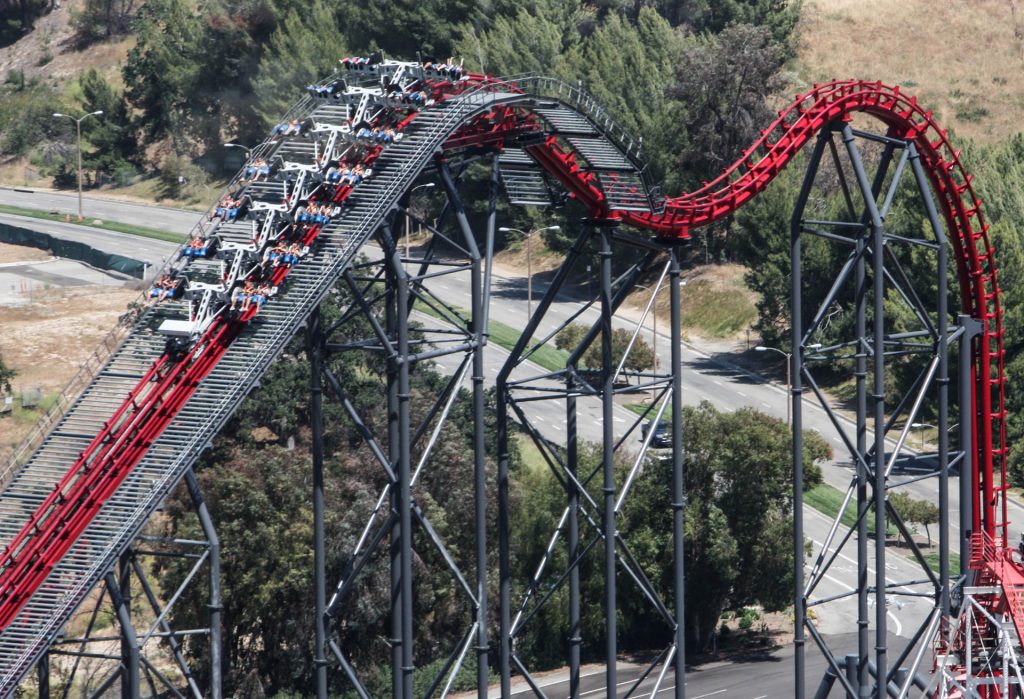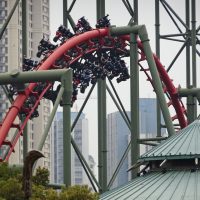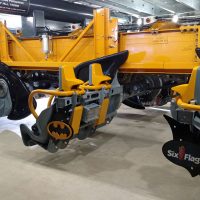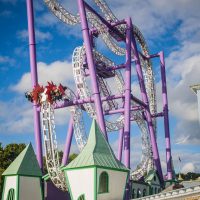a.k.a 4D, ZacSpin, Free Spin, Ball Coaster

It’s the ride that put an end to Arrow Dynamics, but pulled 6-hour plus queues. A “true” 4D ride is a coaster that utilizes four running rails instead of two. The main running rails are the usual rails that the coaster’s train wheels run on – the running wheels, guide wheels, and upstop wheels.
The side pair of rails (or “seat control” rails), located to the outside of and under the main running rails, are run on by wheels attached to ratchet gears (these are what give the trains the characteristic “spikes” on their bodies). The ratchet gears are linked with standard circular gears, which are attached to seats.
As the seat control rails adjust their position relative to the main rails, the ratchet gears attached to the seat control rails move up and down. This up and down motion transfers to the circular gear located inside the train, and corresponds to a vertical spinning motion of the seats.
There have been cheaper models released which work on a free rotating car adjacent to the track rather than on top of it. These Zac Spin and Free Spin coasters have a tiny foot print, being very narrow as they only move in linear directions.
The Original
ARROW DYNAMICS 4D

A highly anticipated ride that promised to redefine what a coaster could be. When it finally opened after months of delays, the $36 million X was hailed as one of the most intense coasters of all time, combining a creative half-above track, half-below track layout with the added bonus of the 4D trains and track. However, the ride began to tear itself apart. The massive weight of the 20-ton trains and poor supporting issues in some areas caused the ride to develop hairline fractures in its trains, track, and supports. Sadly one of Arrow’s most creative projects ever, caused the company’s demise – X’s delays and downtime prompted a lawsuit by Six Flags that bankrupted the historic company.
In 2008, the park spent another $10 million to repair and redesign the coaster, which was renamed X2. Upgrades included new, lighter trains manufactured by S&S Worldwide, as well as audio, mist and fire effects.
Example:
Variations
INTAMIN ZACSPIN/BALL COASTER

Almost a cross between a flat ride and a coaster, the Intamin ZacSpin coaster features a simple track layout that works only vertically and laterally (up and down and forwards and backwards). The coaster never turns a corner.
The trains have free spinning seats on either side of the track and the layouts are designed to allow the seats to spin and rotate as the coaster completes its circuit. Cheap, cheerful, fun and with a small footprint; these rides are perfect for a smaller park, or one wanting to add a new coaster in a small space on a low budget. However, the ride has a reputation for being painful and too intense if the rider load is not balanced due to the axis of rotation.
Examples:
Kirnu at Linnanmäki, Finland
Green Lantern: First Flight at Six Flags Magic Mountain, USA
Insane at Gröna Lund, Sweden
Inferno at Terra Mitica, Spain
S&S – SANSEI TECHNOLOGIES FREE SPIN

Combining the technology acquired drom Arrow Dynamics and the knowledge gained from resolving many of X’s problems, S&S Worldwide manufactured two more X2-style 4D coasters – Eejanaika at Fuji-Q Highland in Japan and Dinoconda at China Dinosaurs Park – before calling it quits with the design type.
On the heels of the successful Intamin ZacSpins, S&S turned to X designer Alan Schilke, who used a larger version of the I-Box track he developed for Rocky Mountain Construction to create the Free Spin coaster in 2015. Using a similar vertical track layout as their Intamin counterparts and free rotating seats, the only major difference between the two (beside the track itself) are the trains and seating arrangement. ZacSpins feature back-to-back seats which rotate around an axle located between the two, whereas the S&S trains have seats that face each other and rotate around the passengers’ center of gravity – allowing for a more comfortable ride.
Examples:
Batman The Ride at Six Flags Fiesta Texas, USA
The Joker at Six Flags Great Adventure, USA
The Joker at Six Flags New England, USA






